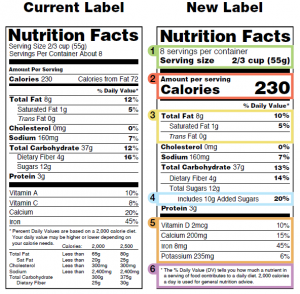The U.S. Food and Drug Administration (FDA) is committed to reducing chronic disease among the population through improved nutrition and healthier eating habits. Thus, on May 27, 2016, the FDA published final rules on the new Nutrition Facts label for packaged foods to reflect new scientific information – the first update in more than 20 years.
With the New FDA nutrition facts label (NFL), the FDA wants to empower consumers with accurate nutrition information and foster innovation toward healthier foods. The new design is based on scientific and nutritional research, and fosters a better understanding of the links between diet and chronic disease. The goal is to make it easier for the consumers to make wise food choices that contribute to improve their eating habits.
The Nutrition Facts label on packaged foods and drinks, which is already appearing on packages, is one of the key activities of the FDA Nutrition Innovation Strategy to improve diet and nutrition and reduce the impact of chronic diseases.
The Nutrition Facts label: news and changes
The goal of the new label is to facilitate customers to choose healthful diets. These are the main changes in the FDA new label:
- It makes counting calories easier.
- The serving size requirements have been updated to provide more realistic nutrition information for each serving.
- It includes added sugars to the label.
- The list of nutrients has been updated according to scientific research and the deficiencies of U.S. citizens.
- Calories from fats have been removed according to scientific research (the type of fat consumed is more important than the amount).
- Daily values for nutrients have been updated and the informative footnote has been improved.
What you need to know about the New FDA nutrition facts label (NFL)
The new label has been designed to help customers make healthier, informed food choices. These are the key changes that you will see in the label:
1. The number of “servings per container” and the “Serving Size” are listed now in larger and/or bolder font.
Other updates to take into consideration in regards to the serving sizes are:
- Serving sizes have been updated according to evidence-based research to better reflect the amount people typically eat and drink.
- New requirements have been included for packages with less than three serving sizes. Package size affects what people eat. When buying packages that are slightly larger than the regular serving size, such as a 20 ounces can of soda (the serving size of a soda is 12 ounces), they are usually consumed in one sitting. To help consumers understand how many calories and nutrients they are getting if they eat or drink the entire package in one sitting, those packages that are slightly larger than a serving size (between one and two serving sizes), calories and other nutrients must be labeled “per package” not “per serving”. For packages that are larger than two typical servings but can reasonably be consumed at one eating occasion (between two and three serving sizes); manufacturers must provide “dual column” labels indicating the number of calories and nutrients “per serving” and “per package”.
2. “Calories” appear larger and bolder in the new label.
3. “Calories from Fat” has been removed from the new label. “Total Fat,” “Saturated Fat,” and “Trans Fat” remain on the label.
4. The inclusion of “Added Sugars” is one of the most important new requirements, and must be shown in grams and as a percent Daily Value (%DV). Added sugars include:
- Sugars that have been added during the processing of foods. For example: sucrose or dextrose.
- Foods packaged as sweeteners. For example: table sugar.
- Sugars from syrups and honey.
- Sugars from concentrated fruit or vegetable juices.
5. The lists of “Nutrients” that are required or permitted on the label has been updated as follows:
- Vitamin D and potassium are now required on the label.
- The actual amount (in milligrams or micrograms) in addition to the %DV must be listed for vitamin D, calcium, iron, and potassium.
- Vitamins A and C are no longer required, but they can be listed by manufacturers voluntarily.
- The Daily Values for nutrients have also been updated based on newer scientific evidence. These are reference amounts of nutrients to consume or not to exceed each day, and are used to calculate the %DV.
6. The footnote at the bottom of the label has been updated to better explain the meaning of %DV or nutritional value in the context of a total daily diet: “The % Daily Value tells customers how much a nutrient in a serving of food contributes to a daily diet. 2,000 calories a day is used for general nutritional advice. “

New FDA nutrition facts label (NFL)
Source: FDA: “The New and Improved Nutrition Facts Label – Key Changes”
The Nutrition Facts label: Compliance dates for manufacturers
Some manufacturers still have time to begin using the new and improved Nutrition Facts label, so both label versions coexist today. However, since 2018, some companies have already started using the new label. According to the FDA, at least 10% of packages being sold nationwide already have the new label.
These are the final compliance dates for the updated Nutrition Facts label:
- Manufacturers with $10 million or more in annual food sales: on May 3, 2018, the FDA extended the compliance dates from July 26, 2018, to January 1, 2020.
- Manufacturers of certain flavored dried cranberries: compliance date is July 1, 2020.
- Manufacturers with less than $10 million in annual food sales: compliance date is January 1, 2021.
- Manufacturers of most single-ingredient sugars (honey, maple syrup and certain cranberry products): compliance date is July 1, 2021.
Implementing the New FDA nutrition facts label (NFL) : requirements and guidance for manufacturers
To help industry comply with the new regulations and implement the new label, the FDA has published several guidance documents and created a website with industry resources and the most frequently asked questions, which provide answers for specific questions from manufacturers.
Here you can find a list of key guidance documents to assist manufacturers with the requirements and implementation of the NFL:
- Dietary fiber: Final guidance documents on dietary fiber (June 2018): “Declaration of Certain Isolated or Synthetic Non-Digestible Carbohydrates as Dietary Fiber on Nutrition and Supplement Facts Labels”.
- Key facts: Final guidance document with questions and answers related to the compliance date, added sugars, declaration of vitamins and minerals, and format of the NFL (November 2018).
- Allulose: Draft guidance on allulose (April 2019).
- Added sugars: Final guidance on the declaration of added sugars on honey, maple syrup, other single-ingredient sugars and syrups, and certain .cranberry products (June 2019).
- Units of measure on the Nutrition Facts label: Final guidance on converting units of measure for Folate, Niacin, and Vitamins A, D, and E on the nutrition and supplement facts labels (August 2019).
- Cranberry products: Final guidance on Policy Related to Cranberry Products with Added Flavorings (August 2019).
- Serving sizes and dual- column labels: Final guidance on Serving Sizes, Dual-Column Labeling (December 2019).
- Compliance for small businesses: Small entity compliance guide for the revision of the nutrition and supplement facts labels (January 2020).
Here you can find the official answers to important questions from manufacturers about how to implement specific aspects of the new label:
- Graphic illustrations of several different formats that can be used as a reference:
- High-Resolution Examples of Different Labels in the New Format(for reference only).
- Nutrition Facts/Datos de Nutrición – Bilingual Label(for reference only).
- Food Labeling Guide.
- Supplement Facts Label.
- Dates of Compliance: New Nutrition Facts Label.
- Added Sugars.
- Serving Size.
- Dual-Column Labels/Single-Serving Containers.
- Folic Acid and Neural Tube Defects Health Claim.
- The Voluntary Nutrition Labeling of Raw Fruits, Vegetables, and Fish.
Nutritional Facts label: Additional resources
Please click below for updated FDA resources regarding the new Nutritional Facts label:
- FDA Nutrition Innovation Strategy
- Final Rule: Revision of the Nutrition and Supplement Facts Labels
- How to Understand and Use the Nutrition Facts Label
- The New Nutrition Facts Label – What’s in it for you?
- Interactive Nutrition Facts Label
- Industry Resources on the Changes to the Nutrition Facts Label
Article by:

















